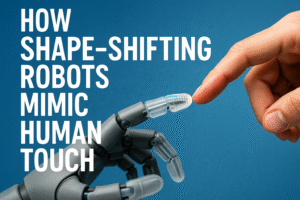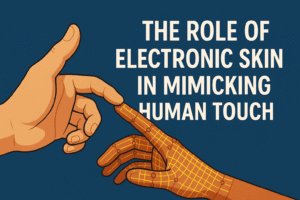Scientists Develop Shape-Shifting Robots That Mimic Human Touch

In a groundbreaking development, scientists have unveiled a set of shape-shifting robots that mimic human touch, marking a new era of human-robot interaction. These robots are designed to simulate a range of tactile sensations, from vibration to firmness, enhancing applications in virtual reality, healthcare, and rehabilitation. These advancements represent a significant leap forward, as they allow robots to not only interact with their environment but also connect with humans in a more lifelike manner through touch.
How Shape-Shifting Robots Mimic Human Touch

The shape-shifting robots that mimic human touch utilize a combination of advanced pneumatic control and flexible materials. These robots are capable of changing their form to simulate a range of tactile sensations that would be impossible for traditional robotic systems. The robots can simulate various textures, from the softness of a human hand to the rigidity of a firm grip.
This technology opens the door to more natural and intuitive interactions between humans and robots. By using pressurized air pouches, the robots can change their shape dynamically, providing users with realistic touch sensations. These robots can also adapt to different environments, enabling them to perform a wide variety of tasks in healthcare and rehabilitation.
Key Innovations in Shape-Shifting Robots
Several prototypes have demonstrated the capabilities of shape-shifting robots that mimic human touch. Among the most notable are TangiGlove and TangiBall.
TangiGlove: Revolutionizing Virtual Reality and Rehabilitation
The TangiGlove is an exoskeleton glove designed to simulate human touch. It is equipped with pneumatic systems that enable it to offer varying levels of resistance, stiffness, and tactile cues. This makes the glove ideal for enhancing virtual reality experiences by providing users with haptic feedback as they interact with virtual environments. Additionally, TangiGlove holds great promise in rehabilitation, as it can simulate real-world touch sensations, assisting patients in their recovery.
TangiBall: A Handheld Robot with Dynamic Tactile Feedback
On the other hand, the TangiBall is a handheld module that can morph from a cube to a sphere, providing physical feedback during interaction. TangiBall’s versatility makes it an excellent tool for rehabilitation, where patients can practice fine motor skills by manipulating the changing shapes. This prototype also holds potential for virtual reality applications, where users can interact with objects that provide tactile sensations, making the experience more immersive.
The Role of Electronic Skin in Mimicking Human Touch

Recent advancements in electronic skin have significantly contributed to the development of shape-shifting robots that mimic human touch. Researchers have created flexible, conductive electronic skin that can detect over 860,000 tiny pathways in the material. This enables the robot to differentiate between various types of touch, such as pressure, temperature, and vibration.
This sensory feedback allows robots to interact with humans in ways that feel more natural. By mimicking the sensitivity of human skin, these robots can perform delicate tasks such as identifying temperature differences or detecting damage caused by sharp objects.
Learn more about this technology at UCL’s Electronic Skin Research.
MIT’s GelPalm: A Step Closer to Human-Like Robotic Hands
Another exciting development in the world of shape-shifting robots that mimic human touch comes from MIT’s CSAIL (Computer Science and Artificial Intelligence Laboratory). The GelPalm is a gel-based robotic hand that mimics the softness and flexibility of human hands. This hand is equipped with sensors that allow it to interact with objects in an extremely precise and sensitive manner, enabling robots to perform tasks that require a delicate touch.
The GelPalm uses RGB LEDs and a camera to capture detailed surface models of objects, allowing the hand to adjust its shape and pressure accordingly. This design brings robots closer to human-like interaction, especially in industries like healthcare, where precision and sensitivity are critical.
Applications of Shape-Shifting Robots in Healthcare and Rehabilitation
The ability of shape-shifting robots that mimic human touch to interact with their environment in such a realistic way has profound implications for healthcare and rehabilitation. In physical therapy, robots can provide patients with realistic tactile feedback, helping them improve their motor skills and regain strength. With the ability to simulate real-world touch, these robots can offer personalized rehabilitation programs that adapt to a patient’s progress.
In addition to rehabilitation, these robots can assist with elderly care. By offering assistance with daily activities and providing companionship, robots can improve the quality of life for elderly individuals. With their human-like touch, these robots can engage in more natural and comforting interactions, helping to combat loneliness and provide a sense of security.
The Future of Human-Robot Interaction

As the technology behind shape-shifting robots that mimic human touch continues to evolve, the possibilities are endless. These robots could eventually become an integral part of everyday life, interacting with humans in ways that are intuitive and natural. Industries such as healthcare, entertainment, and customer service stand to benefit from this technology, as robots become more capable of performing tasks that require human-like interactions.
In the future, we could see robots that not only assist with physical tasks but also engage in meaningful conversations, provide emotional support, and enhance human productivity. The continued development of shape-shifting robots that mimic human touch will redefine how humans interact with machines, leading to more seamless collaboration and better outcomes for various industries.
Conclusion
The development of shape-shifting robots that mimic human touch represents a significant breakthrough in robotics. These robots offer the potential to transform industries such as healthcare, virtual reality, and rehabilitation. With their ability to simulate human-like touch, they can create more natural and intuitive interactions between humans and machines. As this technology continues to improve, we can expect these robots to become more advanced and integrated into our daily lives, offering new possibilities for human-robot collaboration.

